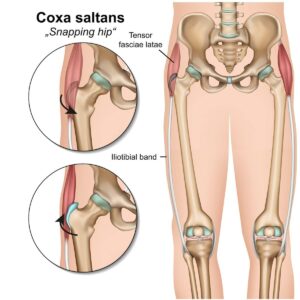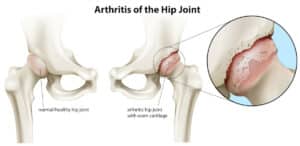Free download: Top 10 Natural & Easy Remedies for Joint Pain from Home. Learn these helpful remedies.
Sciatic nerve pain can create some major problems at nighttime. Many find it difficult to get comfortable and fall asleep because of their sciatica pain.
So, what can be done about this? We all need sleep!
Let’s take a look at the basics of sciatica pain, why it gets worse at night, and best management techniques to find sciatic nerve pain relief at night.
Table of Contents
What is Sciatic Nerve Pain?
We should begin with the basics first: What is sciatic nerve pain?
Sciatic Nerve Anatomy
The sciatic nerve roots originate in the low back or lumbar spine at the spinal nerve levels of L4-S1. It’s literally the largest nerve in the body. No wonder it can be such a pest!
Once the nerve roots leave their origin in the spine, they will form the actual sciatic nerve. The nerve travels down the pelvis and continues down the back of the leg.
Once it reaches the back of the knee, it will branch off into two additional nerve branches: tibial nerve and common peroneal nerve. These branches continue on their own pathways down the rest of the leg to the foot.
Sciatic Nerve Function
The sciatic nerve and its branches innervate a large number of muscles down the back of the leg and into the foot.
This nerve and its branches also allow for proper sensation down the back of the leg. This includes the areas of the back or posterior thigh, back and outer aspect of the lower leg (posterior and lateral regions), and the top and bottom of the foot.
Sciatic Nerve Pain Symptoms
After a little anatomy review, let’s get back to the question of what is sciatic nerve pain?
Any abnormal pressure along any point of the sciatic nerve and its branches can create sciatic pain.
The causes may include a herniated disc, spinal degeneration, spinal stenosis, abnormal spinal alignment (structural such as from scoliosis or positional such as with your sleeping position), muscle tightness, etc.
When this abnormal pressure occurs on the nerve, one or more of the following symptoms may occur:
- Numbness and/or tingling down the back of the leg
- Shooting pain down the back of the leg that may feel like an ache or a sharp burn
- Sudden, electric-type pain radiating down the back of the leg
- Muscle weakness anywhere along the back of the leg
While sciatic nerve pain can be accompanied by lower back pain, this may not always be the case. The reverse is true too. Someone with lower back pain, whether it be an acute episode of low back pain or chronic low back pain, will not necessarily experience sciatic pain.
Why Does Sciatic Nerve Pain Get Worse at Night?

In order to understand why sciatic pain can occur at night, it’s helpful to understand what could possibly happen to the sciatic nerve during the daytime.
Spinal Disc Compression
During the day, the intervertebral discs that cushion our spinal joints experience frequent compression forces. When compression forces are applied to the spinal discs, this can cause loss of fluid and shrinkage of disc height.
Normally at nighttime, our spine and discs are given the opportunity to decompress and recover from the forces of the day. This means encouraging return of fluid to those dehydrated discs and restoring some of that loss disc height.
When we wake up in the morning, we’re as good as new! At least, that’s what should happen.
If the compressive forces from the day are pressing on the sciatic nerve and are not relieved at night during sleep, then your sciatic nerve pain can get worse and disrupt your good night’s sleep.
Muscle Tightness
Now, we’ve primarily discussed what could be causing sciatic pain at night if the problem is coming directly from the spine; however, recall that muscle tightness can also be a cause behind sciatica.
The same concept still applies. If muscle tightness is causing your sciatica symptoms, a lack of properly addressing this tightness and poor sleep positions can make your pain feel worse if continued tension is being placed on the sciatic nerve.
Stress
Another factor to consider is the impact of stress. Stress can absolutely affect any painful area and intensify your symptoms.
At the end of the day when you’ve settled into bed, it’s not uncommon for your mind to start wandering. Unfortunately, it could be wandering and pondering stressful situations and circumstances that you might be dealing with.
This mental stress can cause additional physical stress and tension. If you’re already experiencing pain and tension, this stress could amplify your symptoms and make your sciatica pain worse.
So, what can be done to provide sciatic nerve pain relief at night??
Sleeping Positions
Your sleeping position at night can have a huge effect on your sciatica symptoms. We’ll look at 3 of the most common sleep positions and talk about the pros and cons of each.
Side Sleeping
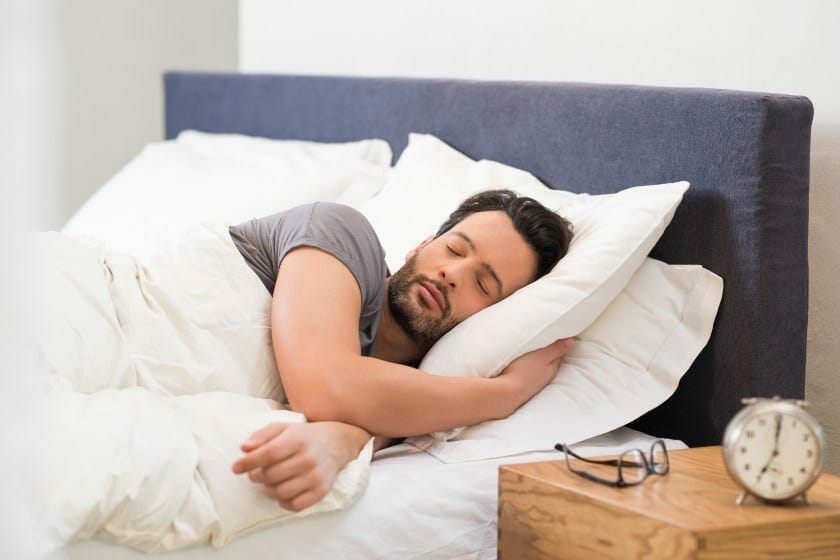
A side sleeping position is probably one of the best sleep positions for promoting sleep quality with sciatica. This is especially true if you curl up into a fetal position with a pillow between your knees.
A fetal position opens the joint spaces in the spine, allowing decompression of the spinal joints. Letting the legs curl up towards the chest can also lengthen the muscles in the lumbar spine, pelvis and back of the upper leg.
This can help to take pressure off the sciatic nerve.
Positioning a pillow between your knees promotes proper alignment of the spine, pelvis and hips, creating a better neutral position for sleeping with sciatica. A thick pillow is usually more effective versus a thin pillow.
You could even consider a full body pillow between your knees.
A possible con for this position is that it may not be the best sleep position if you have naturally tight hip flexors. Your hips flexors are the muscles located in the front of the hip. When the hips are bent, this shortens the muscles.
Sleeping in a fetal position, while helpful for sciatica, may cause your hip flexors to feel tighter in the morning.
If you find side sleeping better for your sleep quality with sciatica, but your hip flexors feel tighter in the morning, check out this stretch for the hip flexors that you can do right from your bed before getting up.
One last consideration for side sleeping is that if you’re experiencing any shoulder pain or discomfort, sleeping on that side may bother the shoulder more.
Back Sleeping
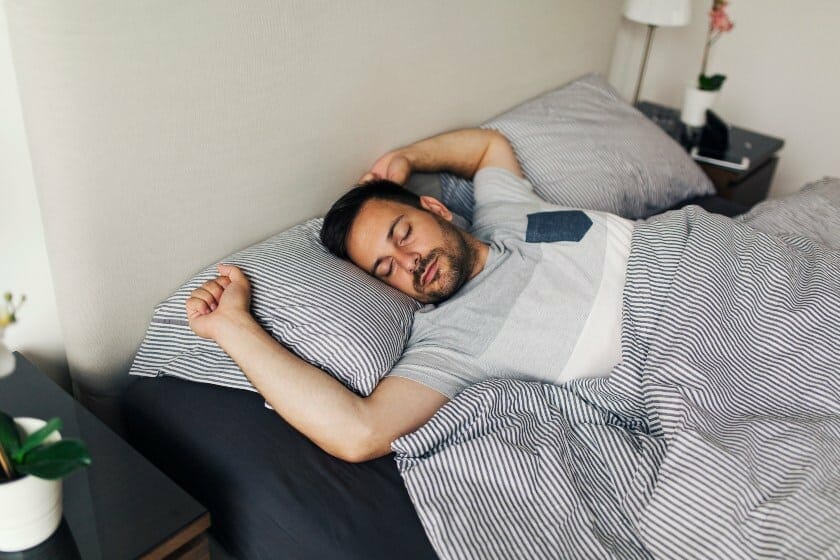
Sleeping on your back is most effective if you have one or two pillows under your knees. A thin pillow may not work as well as a thick pillow, similar to side sleeping with a pillow between your knees.
Positioning a pillow or two under your knees while on your back creates a great decompressive position for the spine, and subsequently relieves pressure from the sciatic nerve.
Some find that they may need their legs more highly elevated than others to achieve this decompressed, neutral position.
While back sleeping with a pillow under your knees can be very helpful for sciatica, some may find sleeping on their back all night just too uncomfortable.
Even if this position is helpful for the sciatic nerve, if you can’t get comfortable, then you still won’t sleep well!
If this is the case, then you may need to keep searching for an alternative sleeping position.
Stomach Sleeping
Stomach sleeping is a little more of a controversial position. Generally speaking, most will not recommend this position as it encourages hyperextension along the entire spine.
Hyperextension along the spine will usually further narrow the joint spaces and has the potential to further compress the already irritated nerve.
It’s for this reason that most find, even with daytime positioning and exercises, flexion-biased positions feel best to relieve sciatic nerve pain relief at night.
If you absolutely can’t avoid sleeping on your stomach, then maybe you can try laying with a pillow underneath the stomach to try and avoid hyperextension.
It’s important to note though that some have actually found the best relief from their sciatica while sleeping on the stomach. This relates to one school of thought and treatment method called the McKenzie Method.
The McKenzie Method aims to treat mechanical back pain. It achieves this through a series of exercise and movement progressions, focusing primarily on spinal extension in the initial movements and positions practiced.
It does, however, incorporate some flexion-based positions towards the end of the progression.
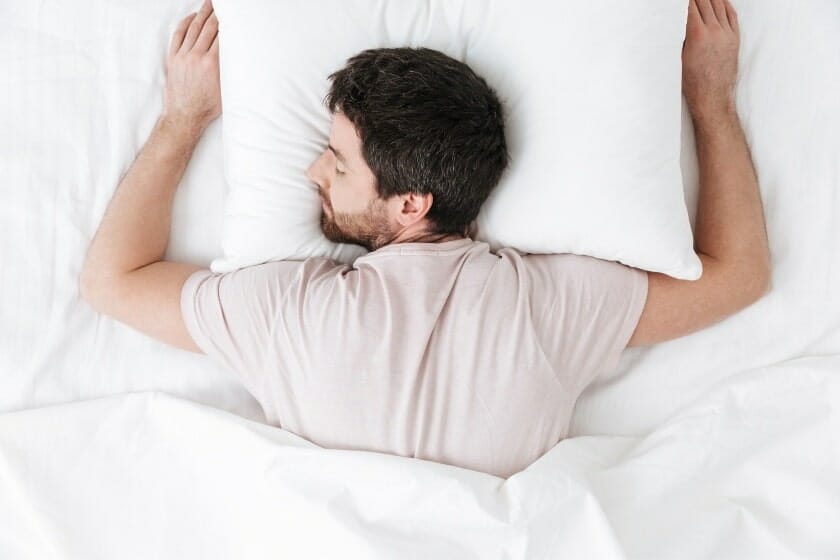
For further demonstration of the top recommended positions to encourage and avoid while sleeping with sciatica, check out the following video.
Mattress Considerations
It’s important to consider the type of mattress you’re using when it comes to relieving sciatica pain at nighttime.
Your body may favor a soft mattress, firm mattress, or more of a medium firm mattress.
A soft mattress may not provide the best support for your spinal alignment, but too firm of a mattress can have that same effect as well and not form the best to the natural curvatures of the body.
Ultimately, you may have to experiment a little with both sleeping positions and mattress types to find what works best for your symptoms.
Sciatic Nerve Stretches
Having a good stretch routine can greatly help improve your sleep quality with sciatica.
Stretches are aimed at improving and loosening tight muscles that surround the sciatic nerve and its branches.
You can even turn most muscle stretches into an actual sciatic nerve glide, or nerve flossing.
Nerve gliding or flossing is an easy, gentle way to mobilize or lengthen the nerves themselves.
All of this, again, is aimed at releasing any possible tension that might be compressing the sciatic nerve.
Supine Hamstring Stretch with a Strap

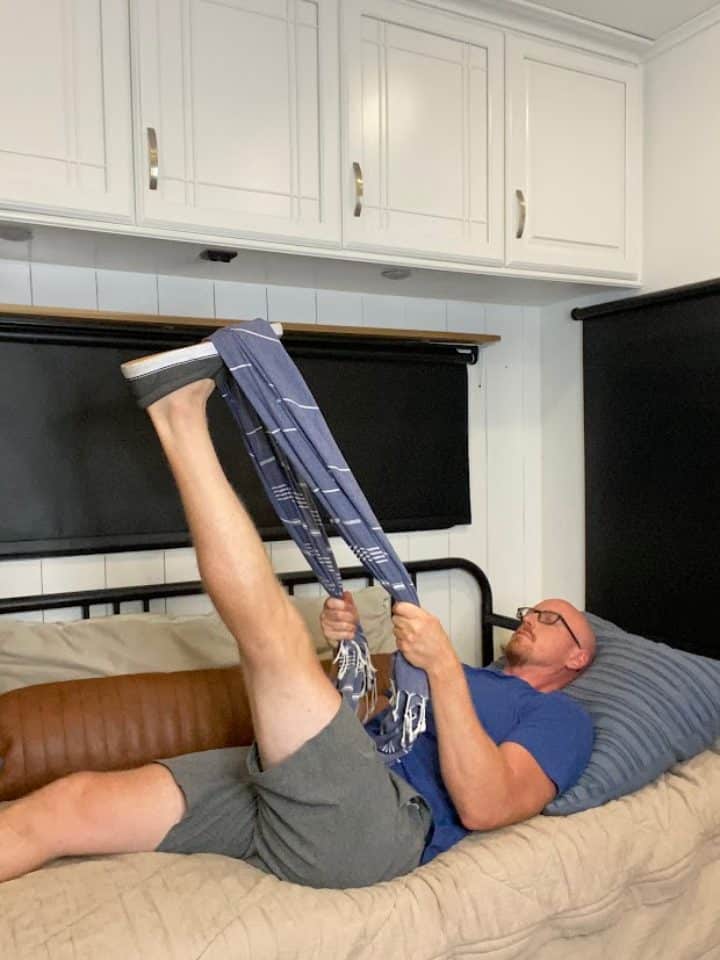
This hamstring stretch can be performed in your bed, on the couch or floor. You’ll need a non-elastic strap, such as a yoga strap, dog leash, belt or towel.
- Lie on your back holding the ends of your strap in the hands.
- Loop the strap around the foot on the leg you intend to stretch.
- Bend the opposite knee so that the foot is flat on the surface.
- Use the arms to slowly pull the leg up into a stretch (make sure to keep the knee on the stretching leg straight).
- Hold anywhere from 30-60 seconds, as tolerated, then lower back down to your starting point.
- Repeat 2x.
Long Sitting Calf Stretch with a Strap
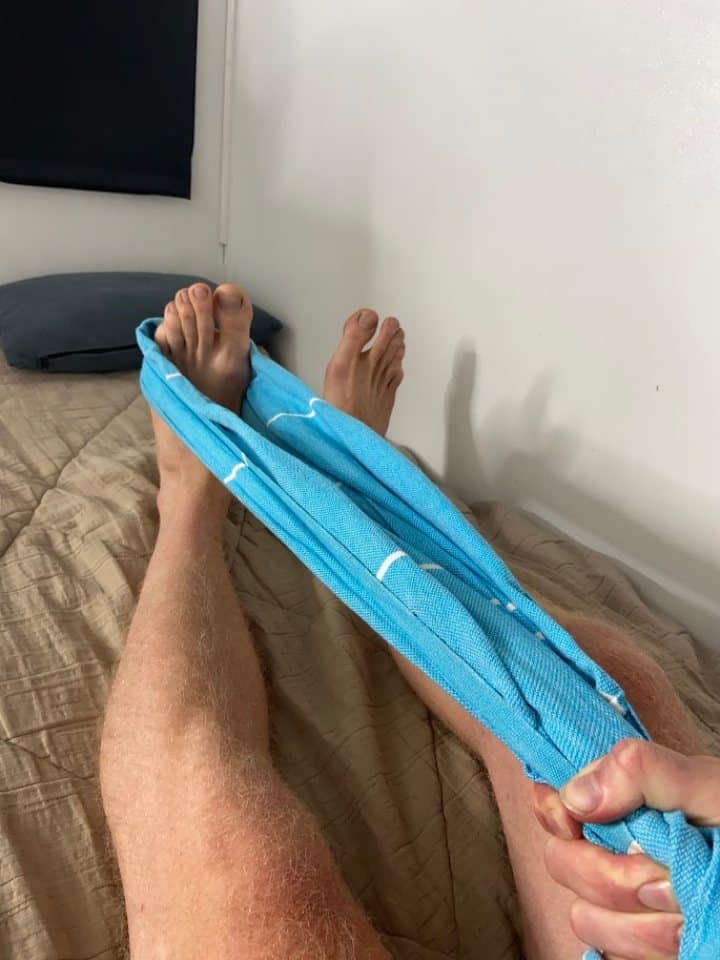
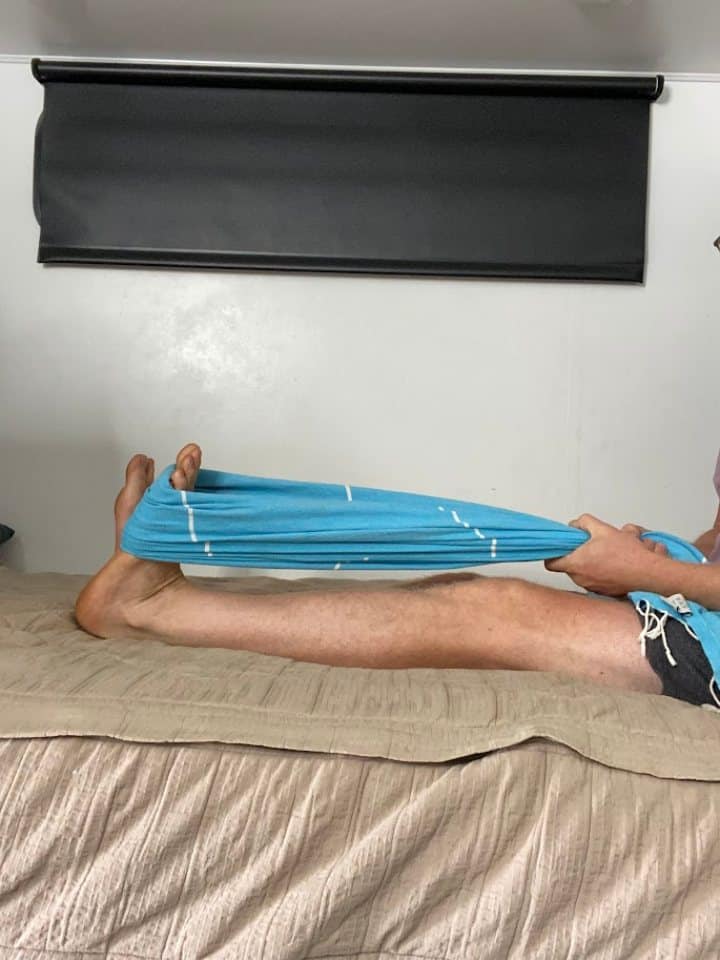
This calf stretch can also be performed in your bed, on the couch or floor. You’ll be using the same non-elastic strap as the above hamstring stretch.
- Position yourself so that you’re sitting upright with the legs in front of you.
- Hold the ends of the strap in your hands and loop it around the foot on the leg you intend to stretch.
- While keeping the stretching leg straight, gently pull back on the strap, flexing your ankle back towards you.
- Once you feel a stretch, hold anywhere from 30-60 seconds, as tolerated, then relax back to your starting position.
- Repeat 2x.
Seated Hamstring Stretch
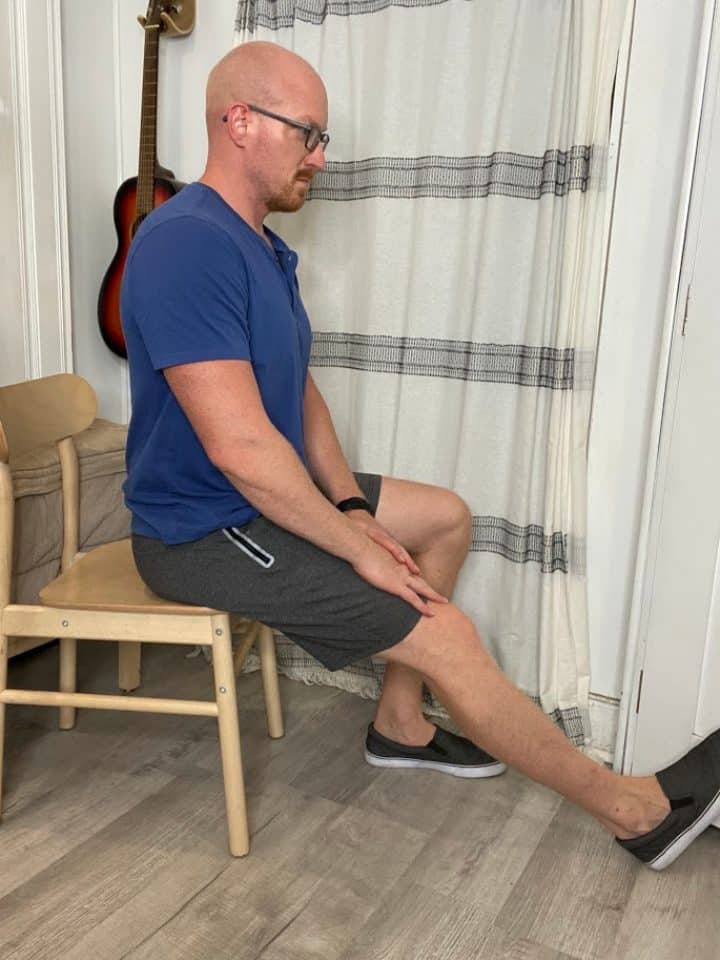
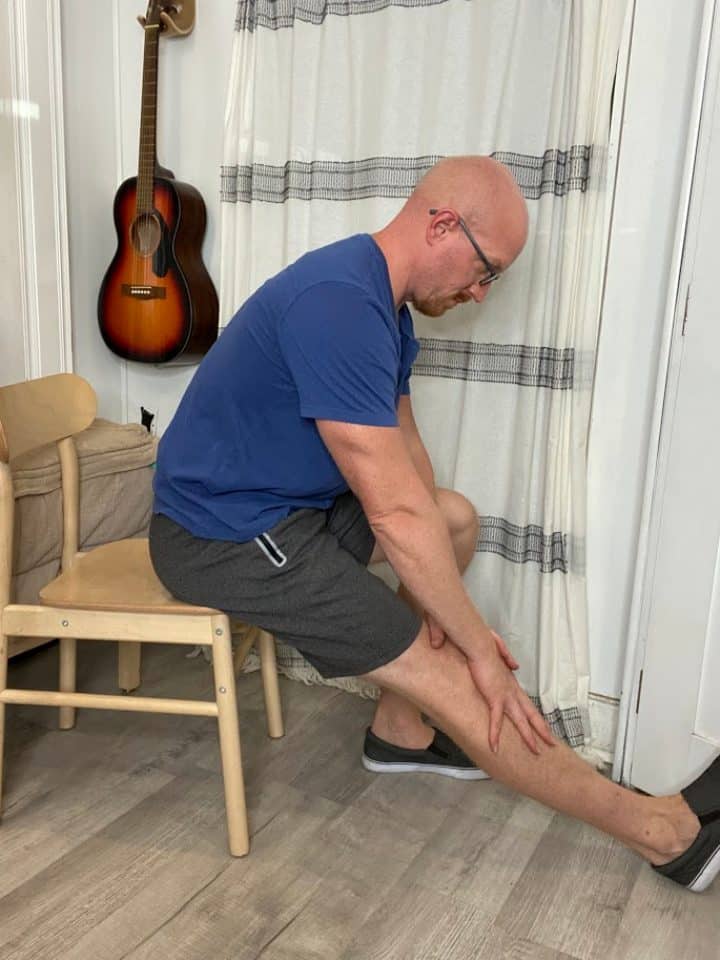
A seated hamstring stretch doesn’t have to use a strap. You’ll be seated at the end of a surface, such as your bed, couch or a chair.
- Extend the leg you intend to stretch directly in front of you.
- While keeping the knee straight, flex the ankle back towards you.
- While keeping the back straight, slowly bend forward from the hips until you feel a stretch behind the leg (you can keep your hands behind you for support if that’s more comfortable).
- Hold this stretch anywhere from 30-60 seconds, as tolerated, then return to your starting position.
- Repeat 2x.
In order to turn each of these stretches into a sciatic nerve glide, once you move into the stretch, you simply need to flex the ankle back and forth for the duration of the stretch. This will provide a glide or stretch specifically for the sciatic nerve.
Here’s a video demo showing how to turn each of the above stretches into a sciatic nerve glide.
Piriformis Stretch
A piriformis stretch can be performed in two basic positions while lying down. Let’s take a look at each:
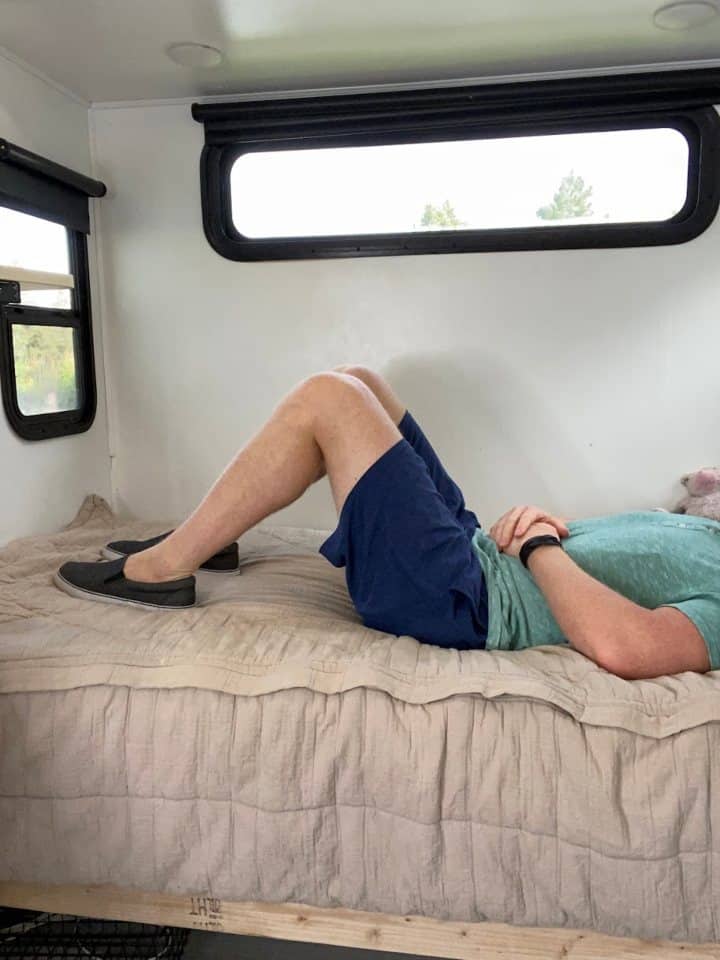
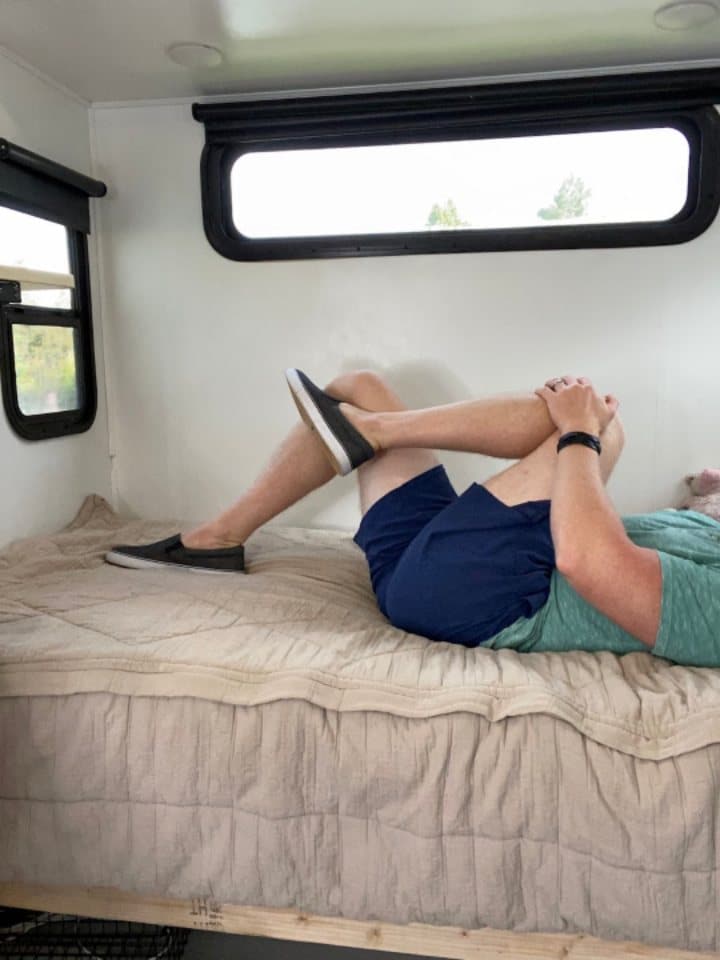
1. While lying flat on the back, bend the knees so the feet are flat on the surface (e.g., bed, couch or floor). Gently pull the leg to be stretched into the chest. Now angle the leg so that the knee is moving towards the opposite hip (don’t let the back lift off the surface).

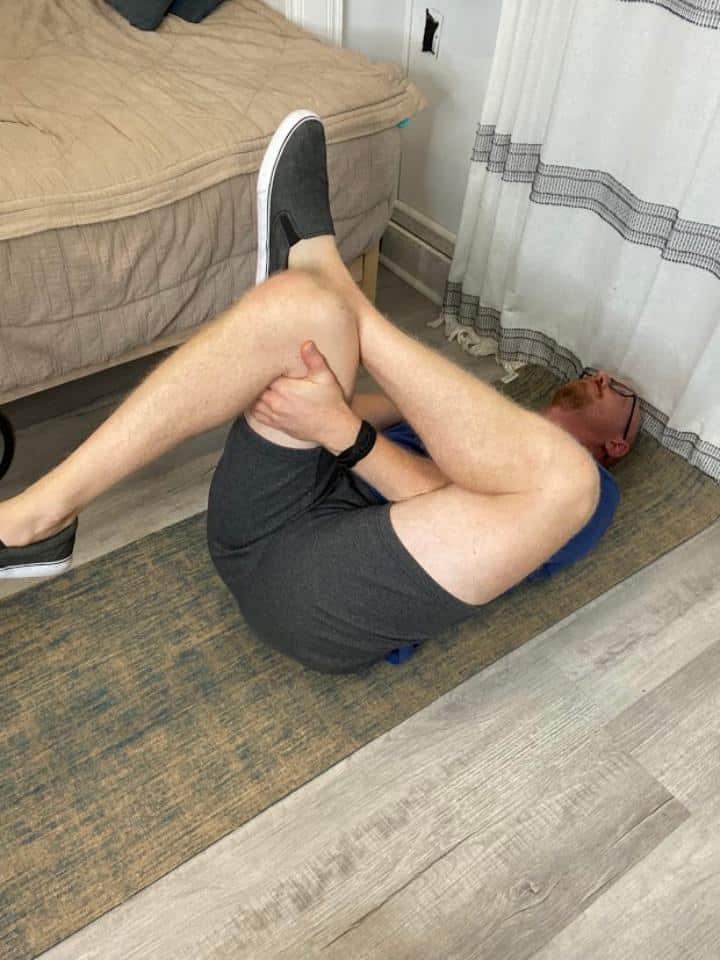
2. While lying flat on the back, bend the knees so the fleet are flat on the surface, just like the above piriformis stretch. Cross the ankle of the leg to be stretched over the opposite thigh, so that the leg looks as if it’s in a Figure 4 position.
Reach the hands behind the thigh of the leg NOT being stretched, and gently pull both legs into the chest.
The first piriformis stretch is a little gentler than the second, so if you’re very tight, you may want to begin with the first example. Make sure to hold each stretch for 30-60 seconds, as tolerated, and repeat each stretch twice.
Stress Management
As previously mentioned, stress can absolutely take a toll on our physical well-being just as much as our mental well-being.
Stress management can actually significantly help with pain reduction and overall pain management in any part of the body, including cases of sciatica while sleeping.
Examples and sources to help with stress management techniques before going to bed may include the following:
- Meditation
- Yoga
- Music therapy
- Turning off electronics well before going to bed
- A warm bath
- Deep breathing
It’s important to find which form of stress management works for you, as everyone responds differently to various stress management techniques.
When to Seek Medical Attention
While we’ve discussed various methods to help achieve sciatic nerve pain relief at night, at what point should you seek medical attention if your symptoms aren’t resolving?
If you’ve had continuation of sciatica while sleeping for up to 2 weeks maximum with no relief, then make an appointment to see your doctor for further examination. You could even see them sooner if the symptoms are persisting with no relief.
If, however, you demonstrate other signs and symptoms with your nighttime sciatica that are considered red flags, then you need to seek immediate medical attention. Some of these red flags may include one or more of the following:
- Saddle paresthesia: Loss of sensation in the area of the thighs and bottom that would touch a saddle if sitting on it.
- Loss of bowel or bladder function, such as incontinence and/or no sensation when this has occurred.
- Extreme, unrelenting pain that doesn’t go away
- Sudden onset of weakness or the legs giving way when trying to stand or walk
Again, if you experience any of the above symptoms with your sciatica, seek emergency medical services right away.
Achieving a Good Night’s Rest

While nighttime sciatica can be quite a nuisance, it’s possible to achieve sciatic nerve pain relief at night.
Make sure to change up and try different sleeping positions if you think this is the source of your pain.
Consider switching out your mattress if it seems time for a replacement anyway.
A regular nighttime routine of stretching and relaxation could also be the ticket to give you the relief you’ve been looking for.
Sciatic nerve pain relief at night is achievable. It all comes down to figuring out how to take pressure off the sciatic nerve!
FAQ:
Can sciatic nerve pain at night go away on its own?
It’s very possible for sciatica to resolve on its own. Even so, if you’ve experienced a case of sciatica that resolved independently, the topics discussed in this article can help reduce your chances of it coming back.
Is sleeping in a recliner bad for sciatica?
Not at all! There are actually some who find that sleeping in a recliner is much better for relieving their sciatica than sleeping on a regular mattress.
Who can I see about my nighttime sciatica?
You could consult with your primary care physician or a physician who is a back specialist, such as a neurologist. They may then refer you to physical therapy or chiropractic care to further address your symptoms.










